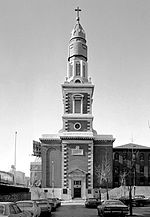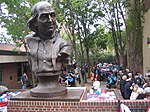St. George's United Methodist Church (Philadelphia)

St. George's United Methodist Church, located at the corner of 4th and New Streets, in the Old City neighborhood of Philadelphia, is the oldest Methodist church in continuous use in the United States, beginning in 1769. The congregation was founded in 1767, meeting initially in a sail loft on Dock Street, and in 1769 it purchased the shell of a building which had been erected in 1763 by a German Reformed congregation. At this time, Methodists had not yet broken away from the Anglican Church and the Methodist Episcopal Church was not founded until 1784.Richard Allen and Absalom Jones became the first African Americans licensed by the Methodist Church. They were licensed by St. George's Church in 1784. Three years later, protesting racial segregation in the worship services, Allen led most of the black members out of St. George's. Allen's camp founded the Mother Bethel A.M.E. Church and the African Methodist Episcopal denomination, while Jones became an Episcopal priest, founding the African Episcopal Church of St. Thomas.In the 1920s a court case saved the church from being demolished to make way for the Benjamin Franklin Bridge. The case resulted in the bridge being relocated.St. George's has experienced many changes during its 249-year history. From 100 members in 1769, the church grew to a peak membership of 3,200 congregants in 1835. The Civil War and industrialization changed the neighborhood; the congregation was reduced to 25 by 1900. Today the church is an active and vibrant Methodist congregation, tracing its roots back to its founding in 1769. The current pastor of St. George's is Reverend Mark Ignatius Salvacion, J.D. St. George's is one of the more than 500 churches in the Eastern PA Conference of the United Methodist Church (http://www.epaumc.org/). St. George's is committed to a theology of love and inclusion, to personal transformation by faith, and to putting God's love to work in the community – the same core values as the first Methodists who met there. St. George's is also continuing with the ongoing work of reconciliation with African-American brothers and sisters for the racial injustices of the past.
Excerpt from the Wikipedia article St. George's United Methodist Church (Philadelphia) (License: CC BY-SA 3.0, Authors, Images).St. George's United Methodist Church (Philadelphia)
Benjamin Franklin Bridge, Philadelphia Center City
Geographical coordinates (GPS) Address Nearby Places Show on map
Geographical coordinates (GPS)
| Latitude | Longitude |
|---|---|
| N 39.954972222222 ° | E -75.146338888889 ° |
Address
Benjamin Franklin Bridge
Benjamin Franklin Bridge
19106 Philadelphia, Center City
Pennsylvania, United States
Open on Google Maps







